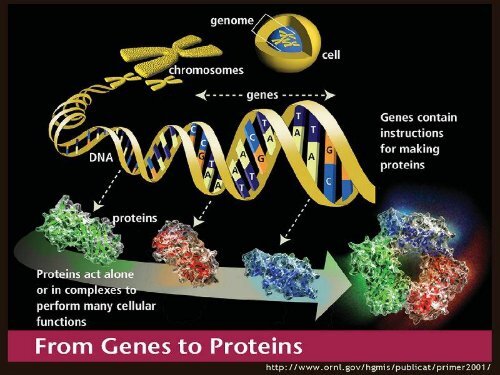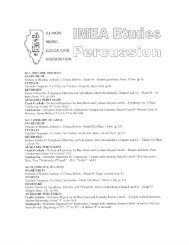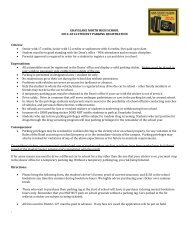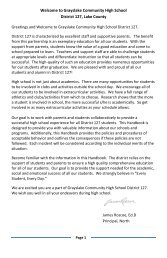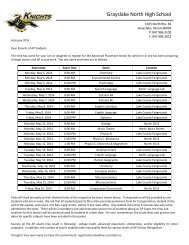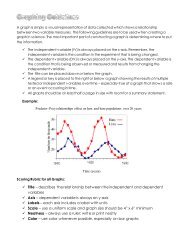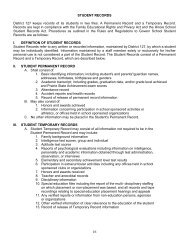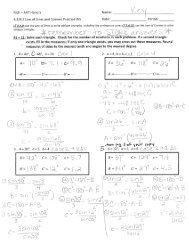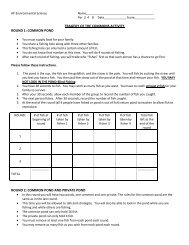17- gene to protein.pdf
17- gene to protein.pdf
17- gene to protein.pdf
You also want an ePaper? Increase the reach of your titles
YUMPU automatically turns print PDFs into web optimized ePapers that Google loves.
How does DNA control a cell?<br />
◦ By controlling Protein Synthesis.<br />
◦ Proteins are the link between<br />
genotype and phenotype.
What makes a firefly glow?
Central Dogma of Gene<br />
Expression
Complete the Comparison chart for DNA and RNA
DNA and RNA are both Nucleic Acids<br />
Structure DNA RNA<br />
Sugar<br />
present<br />
Nitrogen<br />
bases<br />
present<br />
Number of<br />
Strands<br />
Relative<br />
length<br />
deoxyribose<br />
ribose<br />
A, C, G, T A, C, G, U<br />
2 1<br />
Long, contains<br />
hundreds or<br />
thousands of<br />
<strong>gene</strong>s<br />
1 3<br />
types one three<br />
Shorter, about the<br />
length of one <strong>gene</strong><br />
SIMPLE<br />
SKETCH<br />
mRNA<br />
rRNA<br />
tRNA
The Genetic Code<br />
◦ Sequence of bases in DNA correspond<br />
<strong>to</strong> the sequence of amino acids in<br />
<strong>protein</strong>s.<br />
◦ There are only 4 bases but 20 naturally<br />
occurring Amino Acids.<br />
◦ “Codon” = three consecutive bases<br />
code for each amino acid<br />
◦ One <strong>gene</strong> codes for one <strong>protein</strong>
Codon Dictionary<br />
◦ Start- AUG (Met)<br />
◦ S<strong>to</strong>p- UAA<br />
UAG<br />
UGA<br />
◦ 60 codons for the<br />
other 19 AAs.
Dictionary of the <strong>gene</strong>tic code<br />
◦ Each amino acid<br />
except “start” has<br />
multiple codons.<br />
◦ This helps safeguard<br />
against error in<br />
transcription (writing)<br />
or translation<br />
(reading) the code.
Code Redundancy<br />
◦ Third base in a codon shows<br />
"wobble”.<br />
◦ First two bases are the most important<br />
in reading the code and giving the<br />
correct AA.<br />
◦ The third base often doesn’t matter.
Comment<br />
◦ "Wobble" effect allows for 45 types<br />
of tRNA instead of 61.<br />
◦ Reason - in the third position, U can<br />
pair with A or G.<br />
◦ Inosine (I), a modified base in the<br />
third position can pair with U, C, or<br />
A.
Importance of Wobble<br />
◦ Allows for fewer types of tRNA.<br />
◦ Allows some mistakes <strong>to</strong> code for<br />
the same AA which gives exactly<br />
the same polypeptide.
Reading Frame<br />
◦ The “reading” of the code is every three<br />
bases.<br />
◦ Ex: the red cat ate the rat<br />
◦ Ex: ATT GAT TAC ATT<br />
◦ The “words” only make sense if “read”<br />
in this grouping of three.
Code Evolution<br />
◦ The <strong>gene</strong>tic code is nearly universal.<br />
◦ Ex: CCG = proline (all life)<br />
◦ Reason - The code must have evolved<br />
very early. Life on earth must share a<br />
common ances<strong>to</strong>r.<br />
◦ Biotech applications use the universal<br />
nature of DNA <strong>to</strong> move <strong>gene</strong>s from<br />
species <strong>to</strong> species.
Flow of<br />
<strong>gene</strong>tic info<br />
◦ Transcription - <strong>to</strong><br />
write the code <strong>to</strong><br />
mRNA<br />
◦ Site of transcription<br />
is the cy<strong>to</strong>sol<br />
(bacteria) or nucleus<br />
◦ Translation - <strong>to</strong> read<br />
and relate the code<br />
with tRNA and rRNA<br />
◦ Site of translation is<br />
the ribosome
Transcription – the DNA directed<br />
synthesis of RNA<br />
◦ Promoter – specific<br />
nucleotide sequence<br />
along the DNA<br />
◦ In Eukaryotes these<br />
promoters include a<br />
TATA box<br />
◦ Termina<strong>to</strong>r – end of<br />
transcription = UAA,<br />
UAG & UGA
Step by Step through Transcription<br />
◦ INITIATION<br />
◦ RNA polymerase<br />
binds <strong>to</strong> promoter<br />
◦ This cause the DNA<br />
<strong>to</strong> unwind & separate<br />
◦ RNA transcript<br />
begins <strong>to</strong> form
ELONGATION<br />
The template strand is<br />
transcribed by adding<br />
complementary RNA<br />
nucleotides in 5’ 3’<br />
direction<br />
◦ The RNA transcript<br />
grows and DNA<br />
reforms double helix<br />
◦ In Prokaryotes, the<br />
transcript is<br />
immediately usable as<br />
mRNA
TERMINATION<br />
◦ Once a termination<br />
sequence is<br />
transcribed, the<br />
RNA transcript is<br />
released and RNA<br />
polymerase<br />
detaches from DNA<br />
◦ There are three<br />
termination codes
RNA Modification in Eukaryotic cells<br />
◦ 5’ cap and Poly- A tail are added <strong>to</strong> RNA<br />
transcript<br />
◦ Prevents breakdown of DNA<br />
◦ Facilitates passage through nuclear<br />
pores<br />
◦ Cap provides point of attachment at<br />
ribosome
RNA Processing - RNA Splicing<br />
◦ INTRONS – non-coding segments of<br />
eukaryotic <strong>gene</strong>s<br />
◦ EXONS – coding segments<br />
◦ During RNA processing, introns are<br />
removed and exons are spliced <strong>to</strong>gether
RNA Processing - RNA Splicing<br />
◦ Spliceosomes – an<br />
assembly of<br />
snRNPS -<br />
(ribonuclear<br />
<strong>protein</strong>s) + other<br />
<strong>protein</strong>s bind <strong>to</strong> the<br />
end of introns –<br />
recognize code<br />
◦ Newly spliced exon<br />
–only mRNA can<br />
exit nucleus
Functional and Evolutionary<br />
importance of Introns<br />
◦ Introns may play<br />
regula<strong>to</strong>ry roles in the<br />
cell.<br />
◦ Benefit of split <strong>gene</strong>s is<br />
<strong>to</strong> enable a single <strong>gene</strong><br />
<strong>to</strong> encode more than<br />
one kind of <strong>protein</strong>.<br />
◦ Facilitates the shuffling<br />
among <strong>gene</strong>s<br />
promoting evolution
Alternative Splicing<br />
◦ The RNA can be spliced in<strong>to</strong> different<br />
mRNA’s.<br />
◦ Each different mRNA produces a<br />
different polypeptide.<br />
◦ Ex. – this explains how the body can<br />
create infinite number of antibodies.
Another Example<br />
◦ Bcl-X L – inhibits apop<strong>to</strong>sis<br />
◦ Bcl-X S – induces apop<strong>to</strong>sis<br />
◦ Two different and opposite effects!!
DSCAM Gene<br />
◦ Found in fruit flies<br />
◦ Has 100 potential splicing sites.<br />
◦ Could produce 38,000 different<br />
polypeptides<br />
◦ Many of these polypeptides have been<br />
found
Commentary<br />
◦ About 60% of <strong>gene</strong>s are estimated<br />
<strong>to</strong> have alternative splicing sites.<br />
◦ One <strong>gene</strong> does not equal one<br />
polypeptide.<br />
◦ The work of Beadle & Tatum is<br />
being undone with the power of<br />
technology and better<br />
experimentation!
Transcription Review<br />
◦ A biologist inserts a <strong>gene</strong> from a human<br />
liver cell in<strong>to</strong> a bacterial chromosome. The<br />
bacterium transcribes the <strong>gene</strong> in<strong>to</strong> mRNA<br />
and translates it immediately in<strong>to</strong> a <strong>protein</strong>.<br />
The <strong>protein</strong> produced is useless and is<br />
found <strong>to</strong> have many extra amino acids than<br />
does the <strong>protein</strong> made by the eukaryotic<br />
liver cell. Explain Why.
Protein Synthesis<br />
◦ Translation is the<br />
RNA-directed<br />
synthesis of a <strong>protein</strong>.<br />
◦ one codon one<br />
amino acid<br />
◦ Transfer RNA (tRNA)<br />
molecules interpret<br />
the <strong>gene</strong>tic code as<br />
written on the mRNA<br />
transcript
Role of Transfer RNA<br />
◦ Links mRNA codon<br />
<strong>to</strong> its matching<br />
amino acid.<br />
◦ “Anticodon” –<br />
complementary<br />
base sequence <strong>to</strong><br />
mRNA codon.<br />
◦ Amino Acid<br />
attachment site is<br />
located opposite<br />
the anticodon.
Ribosomes<br />
◦ Structure - Large and<br />
small subunit both<br />
composed of <strong>protein</strong><br />
and rRNA.<br />
◦ One enzyme for each<br />
amino acid<br />
◦ Facilitate<br />
• codon – anticodon<br />
complex formation<br />
• peptide bond<br />
formation<br />
◦ Prokaryotic ribosomes<br />
are often the target of<br />
antibiotics
Recognition steps for accurate<br />
translation<br />
◦ 1. Correct match between the tRNA<br />
and the amino acid<br />
◦ Each amino acid has a specific enzyme<br />
that aids in attachment <strong>to</strong> tRNA –<br />
aminoacyl-tRNA synthetase<br />
◦ 2. Codon-anticodon bonding insures<br />
translation
Initiation of Translation<br />
◦ mRNA binds <strong>to</strong> a small ribosomal subunit –<br />
AUG is the “start” sequence.<br />
◦ GTP provides energy needed <strong>to</strong> bring the<br />
large subunit <strong>to</strong> create a complex.<br />
◦ E = exit ; P = <strong>protein</strong> building site and A =<br />
enzyme driven Amino Acid binding site.
Elongation of polypeptide chain s<strong>to</strong>p<br />
◦ 1. Codon<br />
recognition<br />
◦ 2. rRNA serves as<br />
a ribozyme –<br />
catalyst of peptide<br />
bond<br />
◦ 3. translocation –<br />
ribosome shifts<br />
the mRNA by one<br />
codon – both<br />
move relative <strong>to</strong><br />
eachother
Termination<br />
◦ S<strong>to</strong>p codon reaches “A” site.<br />
◦ Release fac<strong>to</strong>r matches s<strong>to</strong>p codon &<br />
<strong>protein</strong> is released.<br />
◦ Ribosome complex disintegrates.
Free vs. Bound Ribosomes<br />
◦ Free Ribosomes<br />
• Protein is needed in cy<strong>to</strong>sol<br />
◦ Bound ribosomes<br />
• Protein is needed at membrane or<br />
beyond via ER<br />
• True of cells that line secre<strong>to</strong>ry organs<br />
or tissues
Signal recognition particle carries the<br />
complex <strong>to</strong> the ER membrane<br />
20 amino<br />
acids long<br />
◦ Signal recognition <strong>protein</strong> temporarily binds<br />
ribosome <strong>to</strong> the ER membrane<br />
◦ Protein is fed in<strong>to</strong> cisterna as it elongates
Mutations –changes in DNA<br />
◦ Chromosomal mutations - large scale<br />
changes <strong>to</strong> chromosomes<br />
◦ Point mutations – small scale changes<br />
in just one base pair of a <strong>gene</strong><br />
• Substitution<br />
• Insertion<br />
• Deletion<br />
Drosophila antennapedia <strong>gene</strong><br />
mutation
Mutations<br />
◦ If Mutation occurs in a gamete or cell<br />
that creates gametes, it may be<br />
transmitted.<br />
◦ If mutation has an adverse affect on<br />
phenotype it is called a <strong>gene</strong>tic disorder<br />
or hereditary disease.
Molecular Basis of Sickle-cell disease<br />
◦ One change in the base sequence leads<br />
<strong>to</strong> the production of an abnormal<br />
<strong>protein</strong>.
Base pair substitutions<br />
◦ Silent mutations – no<br />
effect on encoded<br />
<strong>protein</strong> due <strong>to</strong><br />
redundancy<br />
◦ Missense – still codes<br />
for an amino acid but<br />
not the “right sense”.<br />
◦ Nonsense* – a s<strong>to</strong>p<br />
codon in mid <strong>gene</strong><br />
* leads <strong>to</strong> nonfunctional<br />
<strong>protein</strong>s
Base pair insertion mutations<br />
◦ Addition or loss of base<br />
pairs Disastrous<br />
effect<br />
◦ Frame-shift mutation – #<br />
of nucleotides added or<br />
deleted is not a multiple<br />
of three severe<br />
missense.<br />
◦ why is a multiple of 3<br />
okay?
Frame-shift mutation examples<br />
◦ CAT ATE THE RAT becomes . . .<br />
◦ CAR TAT ETH ERA T<br />
◦ CAR TER ATE THE AT<br />
Disease<br />
related<br />
mutation<br />
statistics
Summary of transcription & translation


